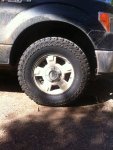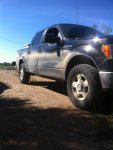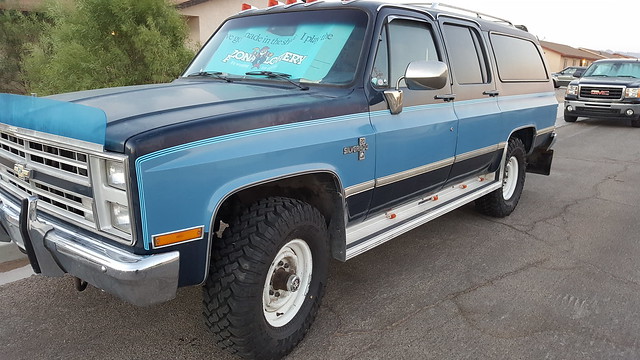You are using an out of date browser. It may not display this or other websites correctly.
You should upgrade or use an alternative browser.
You should upgrade or use an alternative browser.
"Skinny" tires on a Full-Size?
- Thread starter Townsend
- Start date
naturerancher
New member
I just got some 33x10 ST MAX for my truck. No lift, no rubbing and it hasn't affected my MPG's too much. Went from 19.2 to 18.9 MPG according to the computer.
I'm in northern NM and looking at the same setup as you, Cooper 255/80r17 on an F150. How was your experience with this setup, and would you do the same again? Thanks.
Stryder106
Explorer
I think there's a lot of ways to interpret and determine benefits to the varying types of tire. Let's take a look at a few of them. First, a 35" tall tire in both 10.5" and 12.5" widths - when at the same air pressure - the 12.5" is going to have 20% more footprint on the ground. That's basic math. More footprint equals more traction on hard surface and soft surface. If you are intentionally trying to dig down to a firmer surface underneath than I guess the narrower tire is the way to go - but that seems to be counter to the whole "air down" mantra in the first place - which is rule #1 for sand driving. I'm also a drag racer so the "big tire car vs small tire car" debate is very relevant. A smaller tire (10.5"W) is lighter and as such, if the vehicle can get adequate traction - it will run lower ETs and higher speeds than a big tire car. However, that traction is much, much more difficult to attain with the small tire vs the big tire in high hp applications. A big tire car is also far more stable at high speed - again traction and footprint coming into play. FWIW - I have a big tire car with 14.5" wide slicks because I like mitigating the chances of me putting my race car into the wall - which happens a lot with small tire race cars.
//
Second, factory supplied tires are typically grossly undersized and underrated for trucks and SUVs for a reason - sales. A P-Rated tire with a soft sidewall that is only a 31" tall tire will ride softer (more like a car) and be easier to get into the cab (more like a car). Why do the manufacturers do this? Because, in most cases when someone is buying a car - it is a couple or family- and the woman's opinion typically influences 94% of the buying decisions (hence cupholders everywhere - there is a direct correlation). Yes - I used to work on the corporate end for a major auto manufacturer.
//
Third, stability on a full sized vehicle seems like it would be horrible with a tall skinny tire. I know my Avalanche improved dramatically when I went from the stock 265/70-17 P-Rated tire to a 265/70-17 E-Rated tire. Then when I jumped to 285/70-17 E-Rated it got even better. But, when I went to the 35"x12.50"-17 E-Rated tires currently on it, it not only completely stabilized the truck, but it actually LOOKS like the right size tire on it now (which blew me away since I was expecting the tire to LOOK huge on it).
//
I agree there is a point of diminishing return regarding tire size vs performance and fuel economy, but I think that point varies widely depending on vehicle size/weight and type of terrain being used in.
//
Second, factory supplied tires are typically grossly undersized and underrated for trucks and SUVs for a reason - sales. A P-Rated tire with a soft sidewall that is only a 31" tall tire will ride softer (more like a car) and be easier to get into the cab (more like a car). Why do the manufacturers do this? Because, in most cases when someone is buying a car - it is a couple or family- and the woman's opinion typically influences 94% of the buying decisions (hence cupholders everywhere - there is a direct correlation). Yes - I used to work on the corporate end for a major auto manufacturer.
//
Third, stability on a full sized vehicle seems like it would be horrible with a tall skinny tire. I know my Avalanche improved dramatically when I went from the stock 265/70-17 P-Rated tire to a 265/70-17 E-Rated tire. Then when I jumped to 285/70-17 E-Rated it got even better. But, when I went to the 35"x12.50"-17 E-Rated tires currently on it, it not only completely stabilized the truck, but it actually LOOKS like the right size tire on it now (which blew me away since I was expecting the tire to LOOK huge on it).
//
I agree there is a point of diminishing return regarding tire size vs performance and fuel economy, but I think that point varies widely depending on vehicle size/weight and type of terrain being used in.
Haf-E
Expedition Leader
Sure - I don't disagree with your statements - but many times you can go with a taller tire if it is skinny without a lift or new wheels - which often is required with a wider tire. So the more fair comparison is a taller skinny tire (like a 35 inch) vs. a shorter wider tire (like a 33 inch). With that comparison - the taller tire has a longer contact patch because it has a larger diameter, which often makes up for the narrower width. The taller tire also gives an inch more clearance also in this example.
Bringing this thread back because I need tires. Broke a belt today on one of my 285/75r16s while towing a 6000lb trailer. Truck has stock 6.5" wheels and a small lift. I like the look but think the tires are too wide.
Getting ready to head out to Colorado with the trailer and want to do some trails out there.
Any recommendations?

Getting ready to head out to Colorado with the trailer and want to do some trails out there.
Any recommendations?

Last edited:
Hilldweller
SE Expedition Society
Bringing this thread back because I need tires. Broke a belt today on one of my 285/75r16s while towing a 6000lb trailer. Truck has stock 6.5" wheels and a small lift. I like the look but think the tires are too wide.
Getting ready to head out to Colorado with the trailer and want to do some trails out there.
Any recommendations?

I'm going to go with Toyo AT3 in a 255/85-17 soon. Quadratec has them for $193 if you apply a forum discount (WranglerForum) and Discount Tire will price match.
This will be on my 2020 Ram 1500 Classic, btw. My trailer is in the 3000 pound range.
jadmt
ignore button user
True. i tried to order a set of Toyo at3’s from discount tire and they told me they were on national back order. Tirebuyer.com however had them in stock.You may just want to pick 3 or 4 and go see what is in stock/available quickly. Hearing about lots of tires back ordered lately.
jadmt
ignore button user
I just installed some at3 and a bit disappointed. I have had several sets of at2’s and the at3’s are louder and louder than the st maxx’s they replaced and also louder than the falken at3w’s i also run. Also discount tire could not get them as they told me they were on national backorder with no eta. Tirebuyer.com had them and had the best price on them. They look good.I'm going to go with Toyo AT3 in a 255/85-17 soon. Quadratec has them for $193 if you apply a forum discount (WranglerForum) and Discount Tire will price match.
This will be on my 2020 Ram 1500 Classic, btw. My trailer is in the 3000 pound range.

Last edited:
I'm going to go with Toyo AT3 in a 255/85-17 soon. Quadratec has them for $193 if you apply a forum discount (WranglerForum) and Discount Tire will price match.
This will be on my 2020 Ram 1500 Classic, btw. My trailer is in the 3000 pound range.
Unfortunately not available in 255/85r16
jadmt
ignore button user
235/85-16 i bet..Unfortunately not available in 255/85r16
1stDeuce
Explorer
255/85R16 Mastercraft CXT. Price good, made in the USA by Cooper. Traction good too. Replaced same size Maxx's on my truck and Jeep, think I like the CXT's a little better. Pic in truck thread of sig.Bringing this thread back because I need tires. Broke a belt today on one of my 285/75r16s while towing a 6000lb trailer. Truck has stock 6.5" wheels and a small lift. I like the look but think the tires are too wide.
Getting ready to head out to Colorado with the trailer and want to do some trails out there.
Any recommendations?
Good luck!!
Similar threads
- Replies
- 7
- Views
- 3K
- Replies
- 7
- Views
- 1K
- Replies
- 2
- Views
- 3K
- Replies
- 56
- Views
- 17K



